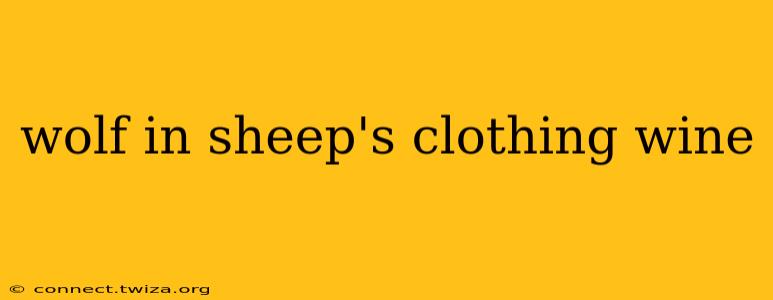The phrase "wolf in sheep's clothing" conjures images of deception and hidden danger. In the world of wine, this idiom takes on a literal and figurative meaning, referring to wines that deceptively present themselves as something they are not. This can range from mislabeled varietals to wines produced with substandard practices, marketed to unsuspecting consumers. This article will delve into the various ways wines can masquerade under a false guise and offer guidance on how to avoid becoming a victim of this vinous deception.
What Does "Wolf in Sheep's Clothing" Mean in the Context of Wine?
In the wine industry, a "wolf in sheep's clothing" typically refers to wines that are misleadingly presented to consumers. This can manifest in several ways:
- Mislabeling: This is the most egregious form of deception. A wine might be labeled as a specific varietal (e.g., Cabernet Sauvignon) when it contains a significantly different grape or blend. This is illegal in many regions and carries significant penalties for producers, though instances still occur.
- Region Misrepresentation: Similarly, a wine might claim origin from a prestigious region (e.g., Burgundy) when it was actually produced elsewhere, capitalizing on the reputation and higher prices associated with that area. This practice is particularly common with less expensive wines attempting to mimic high-end styles.
- False Advertising: A wine might be marketed with exaggerated claims about its quality, age, or production methods to inflate its perceived value. Images and descriptions can be manipulated to create a false impression of sophistication or heritage.
- Substandard Practices: While not always a direct misrepresentation, wines produced with poor viticultural or winemaking practices can fall under this category. These wines may not be explicitly mislabeled but fail to live up to the expectations set by their price point or branding.
How Can I Identify a "Wolf in Sheep's Clothing" Wine?
Identifying deceptive wines requires a discerning eye and some knowledge of the wine industry. Here are some key indicators:
- Unusually Low Prices for Prestigious Regions: If a wine from a renowned region (like Bordeaux or Napa Valley) is drastically cheaper than comparable bottles, proceed with caution. It's possible that the region's name is being used to mask a lower-quality product.
- Vague or Unclear Labeling: Look for ambiguous descriptions or labels that lack specifics. Avoid wines with overly generic descriptions that lack details about the grape varietal, region, or production methods.
- Unfamiliar Producers: While many excellent wines come from smaller, lesser-known producers, exercise caution with completely unknown brands, especially if they claim to hail from well-established regions.
- Overly Sensational Marketing: Be wary of overly exaggerated claims or marketing materials that prioritize style over substance. Focus on the details of the wine itself rather than the flashy presentation.
- Research the Producer: Before buying, research the producer online. Look for reviews, articles, and information about their winemaking practices to assess their reputation and credibility.
What are the Legal Ramifications for Mislabeling Wines?
The legal ramifications for mislabeling wines vary depending on the jurisdiction. Most countries have strict regulations governing wine labeling, including requirements for accuracy in terms of varietal composition, geographic origin, and production methods. Violations can result in significant fines, legal action, and damage to the producer's reputation. Consumers are encouraged to report suspected mislabeling to the relevant authorities.
Are There Certain Types of Wine More Prone to Mislabeling?
While any type of wine can be subject to mislabeling, some types are more commonly targeted due to their high demand and price point. Wines from prestigious regions or those associated with specific grape varietals (e.g., Pinot Noir from Burgundy, Cabernet Sauvignon from Napa Valley) are frequently imitated.
How Can I Protect Myself from Buying a Deceptive Wine?
The best way to protect yourself from purchasing a "wolf in sheep's clothing" wine is to be an informed consumer. Do your research, read reviews from reputable sources, and prioritize quality over price. Support reputable producers and wine merchants who prioritize transparency and ethical practices.
By staying informed and exercising caution, you can navigate the world of wine with greater confidence and avoid falling victim to deceptive practices. Remember, a little research goes a long way in ensuring you're enjoying a truly authentic and enjoyable glass of wine.
